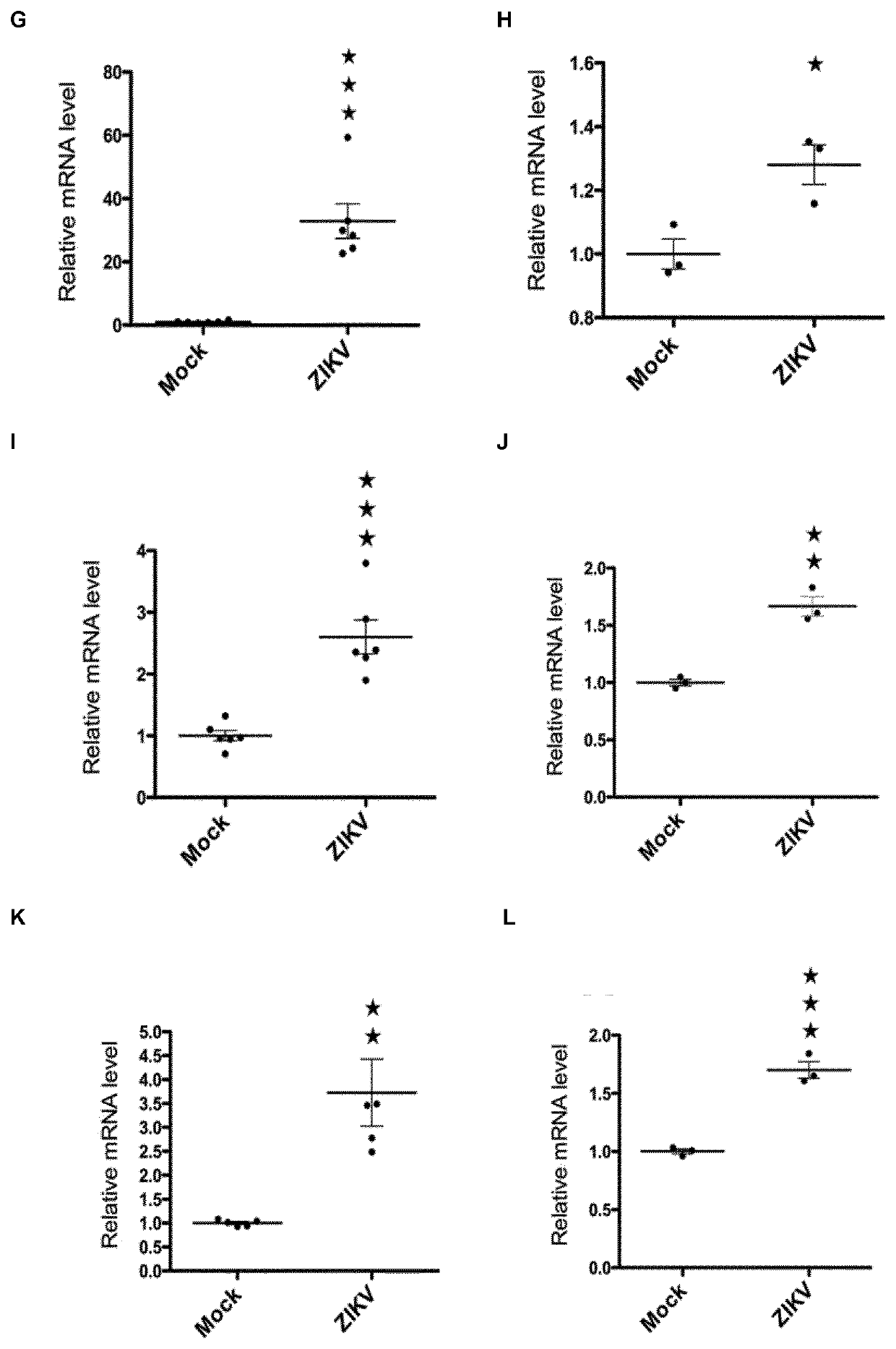Perk and ire-1a inhibitors against neurodevelopmental disorders
a neurodevelopmental disorder and inhibitory technology, applied in the field of perk and ire1a inhibitors against neurodevelopmental disorders, can solve the problems of reducing head circumference and brain size, affecting important developmental processes, and affecting the generation and survival of neurons, so as to prevent or treat endoplasmic reticulum (er) stress disorders
- Summary
- Abstract
- Description
- Claims
- Application Information
AI Technical Summary
Benefits of technology
Problems solved by technology
Method used
Image
Examples
example 1
[0426]qRT-PCR analyses of genes involved in the UPR pathways on extracted RNA from human occipital cortices of three microcephalic ZIKV-infected fetuses in the second trimester (ZIKV#1, 25GW; ZIKV#2 and ZIKV#3, 22GW), and of three uninfected fetuses of similar gestational ages (WT, 21GW, 23GW and 24GW). In contrast to uninfected fetuses, ZIKV-infected cortices exhibited an upregulation of the myxovirus resistance proteins-encoding gene (MX1, FIG. 1A), which is reported to be induced upon viral infection, as well as several molecular components of the ER stress pathway and of the PERK-ATF4 arm of UPR (FIGS. 1B-1F). Together, these results suggest that ZIKV induces ER stress and triggers UPR in cortical progenitors of fetuses during pregnancy (FIG. 1P).
[0427]To experimentally test this hypothesis, we infected cultured human neural stem cells (hNSCs), which display features of cortical progenitors, with ZIKV (H / PF / 2013) for two hours, and analyzed ER stress and UPR molecular signatures...
example 2
[0428]ZIKV particles were intracerebroventricularly (ICV) injected into the forebrain at E12.5 and brains were analyzed at E18.5. Infected mouse brains were microcephalic and were significantly lighter (FIG. 2A), with smaller cortical dimensions (FIG. 2B-D) when compared to mock-infected embryos. Similar results were obtained in newborn pups. Importantly, the cortical thickness of ZIKV-infected brains was significantly reduced. Furthermore, ZIKV-infected brains exhibited a strong reduction of deeper (Tbr1+ or Ctip2+ neurons) and upper layer neurons (Satb2+ neurons), as well as a severe disruption in their laminar organization, as compared to uninfected brains. Microdissected cortices from ZIKV-infected embryos showed an upregulation of the AP marker Pax6 (FIG. 2E) but not of the intermediate progenitor (IP) marker Tbr2 (FIG. 2F). These data were further confirmed by immunolabelings. We also observed an overall relative reduction of expression of neuronal markers (FIGS. 2G-2H). These...
example 3
[0429]To test whether the deregulation of UPR induced by ZIKV-infection results in the impairment of this neurogenic balance, we performed ICV injection of ZIKV in E12.5 mouse brains, followed by in utero electroporation of GFP-expressing plasmids one day later to fate-map APs at E14.5 (APs, immature IPs and IPs, neurons) (FIGS. 3A-B). The phenotype of the “direct progeny” of targeted APs was then assessed by immunohistochemistry (FIGS. 3B-D). In order to characterize the fate of GFP+cells, we subdivided them into APs (Sox2+, Tbr2- or Tbr2-, Tbr1-), immature IPs (Sox2+,Tbr2+or Tbr2+, Tbr1-), IPs (Sox2-, Tbr2+or Tbr2+, Tbr1+), or neurons (Sox2-, Tbr2- or Tbr2-, Tbr1+). The analyses of ZIKV-infected GFP+APs (as detected by anti- NS1 (non-structural protein 1) antibodies and similarly to anti-flavivirus group antigen antibody 4G2) showed that the majority of GFP+ ZIKV-infected cells were proliferating (65.8±9.6; n=5 brains; Mean±SEM) and, compared to GFP+ cells in uninfected brains, ga...
PUM
| Property | Measurement | Unit |
|---|---|---|
| particle size | aaaaa | aaaaa |
| weight | aaaaa | aaaaa |
| weight | aaaaa | aaaaa |
Abstract
Description
Claims
Application Information
 Login to View More
Login to View More - R&D
- Intellectual Property
- Life Sciences
- Materials
- Tech Scout
- Unparalleled Data Quality
- Higher Quality Content
- 60% Fewer Hallucinations
Browse by: Latest US Patents, China's latest patents, Technical Efficacy Thesaurus, Application Domain, Technology Topic, Popular Technical Reports.
© 2025 PatSnap. All rights reserved.Legal|Privacy policy|Modern Slavery Act Transparency Statement|Sitemap|About US| Contact US: help@patsnap.com



